Time Travel Research Center © 2005 Cetin BAL - GSM:+90 05366063183 - Turkey/DenizliEngine List
The RS 10 from Star Born by Andre Norton, 1957
Judging from the size of the people, the ship is approximately 70
meters high (240 feet)
You can spend lots of time researching spacecraft propulsion systems. But you are in luck, I've got some data for you. Most of this is from Philip Eklund's invaluable boardgame ROCKET FLIGHT. (order here), the impressive Spaceship Handbook, and the indispensable Space Propulsion Analysis and Design. The rest is from various places I found around the internet, and no, I didn't keep track of where I got them from. Use at your own risk. If you don't like the values in the table, do some research to see if you can discover values you like better. Also note that the designs in the list are probably optimized for high exhaust velocities at the expense of thrust. There is a chance that some can be altered to give enough thrust for lift-off at the expense of exhaust velocity. Some engines require electricity in order to operate. These have their megawatt requirements listed under "Power Requirements". With these engines, the Engine Mass value includes the mass of the power plant (unless the value includes "+pp", which means the mass value does NOT include the mass of the power plant). The power plant mass can be omitted if the spacecraft relies on beamed power from a remote power station. Alas, I could find no figures on the mass of the power plant. If the plant is nuclear, it probably has a mass of around 0.5 to 10 tons per megawatt. I agree, that isn't much help. Sorry. Efficiency is the percentage of the power requirements megawatts that are actually turned into thrust. The rest becomes waste heat and has to be removed with heat radiators. T/W >1.0 = Thrust to Weight ratio greater than zero? This boils down to: can this be engine be used to take off from the Earth's surface? If the answer is "no" use it only for orbit to orbit maneuvers. It is calculated by figuring if the given thrust can accelerate the engine mass greater than one gee of acceleration. Most propulsion systems fall into two categories: SUV and economy. SUV propulsion is like an SUV automobile: big and muscular, but the blasted thing gets a pathetic three miles to the gallon. Economy propulsion has fantastic fuel economy, but has trouble climbing low hills. In the world of rockets, good fuel economy means a high "specific impulse" (Isp) and high exhaust velocity. And muscle means a high thrust. The only vaguely possible propulsion system that has both high exhaust velocity and high thrust is the Nuclear Salt Water Rocket, and not a few scientist have questions about its feasibility. Well, actually there also is Project Orion, but that has other problems (see below). In science fiction, one often encounters the legendary "fusion drive", which is a high exhaust velocity + high thrust propulsion system that modern science isn't sure is even possible. From my limited understanding, the basic problem is how to keep the engine from vaporizing. Fp = (F * Ve ) / 2 where The problem is that at high enough values for exhaust velocity and thrust, the amount of watts in the jet is too much. "Too much" is defined as: if only a fractional percentage of those watts are lost as waste heat, the spacecraft glows blue-white and evaporates. The size of the dangerous fractional percent depends on heat protection technology. There is a limit to how much heat that current technology can deal with, without a technological break-through. 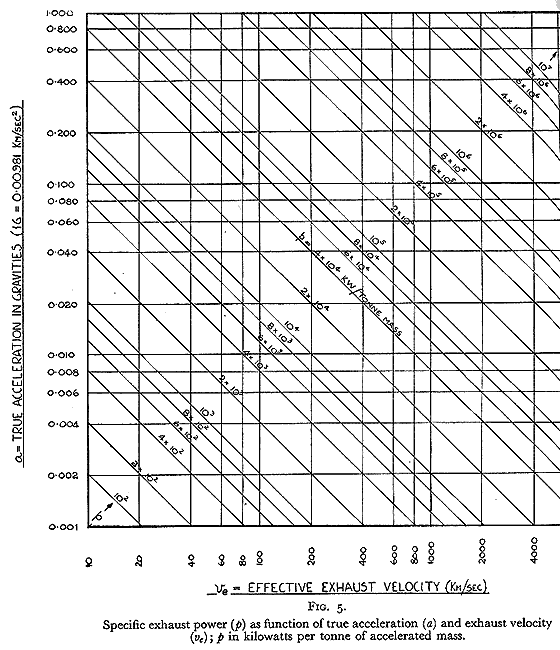
chart from "The Atomic Rocket" by L. R. Shepherd,
Ph.D., B.Sc., A.Inst.P., & A. V. Cleaver, F.R.Ae.S., 1948. Collected
in Realities of Space Travel
Jerry Pournelle says (in his classic A STEP FARTHER OUT) that an exhaust velocity of 28,800,000 cm/s corresponds to a temperature of 5 million degrees Kelvin. As an exceedingly rough approximation: Ae = (0.5 * Am * Av2) / B where A slightly less rough approximation: Qe = (Ve / (Z * 129))2 * Pw where The interior of stars are 5 million degrees Kelvin, but few other things are. How do you contain temperatures of that magnitude? If the gadget is something that can be mounted on a ship smaller than the Queen Mary, it has other implications. It is an obvious defense against hydrogen bombs, for starters. Larry Niven postulates something like this in his "Known Space" series, the crystal-zinc tube makes a magic force field which reflects all energy. Niven does not explore the implications of this. However, Niven and Pournelle do explore the implications in THE MOTE IN GOD'S EYE. The Langson Field is used in the ship's drive, and as a force screen defense. The Langson field absorbs energy, and can re-radiate it. As a defense it sucks up hostile laser beams and nuclear detonations. As a drive, it sucks up and contains the energy of a fusion reaction, and re-radiates the energy as the equivalent of a photon drive exhaust. (And please remember the difference between "temperature" and "heat". A spark from the fire has a much higher temperature than a pot of boiling water, yet a spark won't hurt your hand at all while the boiling water can give you second degree burns. The spark has less heat, which in this context is the thrust power in watts.) In his Known Space novels, Larry Niven invented The Kzinti Lession. It states that the more efficient a reaction drive is, the better a weapon it makes. The warlike Kzinti invaded the solar system, figuring that humanity would be a pushover since the pacifist humans of the time had no weapons. Humans showed the Kzin the error of their ways by annihilating Kzinti warships with laser arrays used for solar sails, multi-million degree fusion exhausts, and photon drives that were basically titanic lasers. So keep in mind that the higher the exhaust velocity of the rocket engine, the more damage it will do to anything unfortunate enough to be in the path of the exhaust. All drives listed in the table who's names end in "MAX" require some sort of technological breakthrough to to prevent the engine from vaporizing. If these figures result in disappointing rocket performance, in the name of science fiction you can tweak some of them and claim it was due to a technological advance. You are allowed to tweak anything who's name does not end in "MAX". You can alter the Thrust, Engine Mass, and/or the Eff, but no other values. If there is a corresponding "MAX" entry for the engine you are tweaking, you cannot alter any of the values above the "MAX" entry (i.e., you are not allowed to tweak NTR-SOLID-DUMBO's thrust above 7,000,000, which is the value in the NTR-SOLID MAX entry). The engines are sorted by thrust power, since that depends on both exhaust velocity and thrust. So engines that high in both of those parameters will be towards the end of the list. This is useful for designers trying to make spacecraft that can both blast-off from a planet's surface and do efficient orbital transfers. If one was trying to design a more reasonable strictly orbit-to-orbit spacecraft one would want the engine list sorted by exhaust velocity. And surface-to-orbit designers would want the list sorted by thrust.
ACMF: ANTIPROTON-CATALYZED MICROFISSION / INERTIAL CONFINMENT FISSION AIM: ANTIPROTON-INITIATED MICROFUSION / INERTIAL CONFINMENT FUSION AM-Beam: ANTIMATTER BEAM CORE. Microscopic amounts of antimatter are reacted with equal amounts of matter. The charged pions from the reaction are used directly as thrust, instead of being used to heat a propellant. They are channeled by a magnetic nozzle. Without a technological break-through, this is a very low thrust propulsion system. All antimatter rockets produce dangerous amounts of gamma rays. AM-Gas: ANTIMATTER GAS CORE. Microscopic amounts of antimatter are injected into large amounts of water or hydrogen propellant. The intense reaction flashes the propellant into plasma which exits through the exhaust nozzle. Magnetic fields constrain the charged pions from the reaction so they heat the propellant, but uncharged pions escape and do not contribute any heating. Less efficient than AM-Solid core, but can achieve a higher specific impulse. For complicated reasons, a spacecraft optimized to use an antimatter propulsion system need never to have a mass ratio greater than 4.9, and may be as low as 2. No matter what the required delta V, the spacecraft requires a maximum of 3.9 tons of reaction mass per ton of dry mass, and a variable amount of antimatter measured in micrograms to grams. AM-Plasma: ANTIMATTER PLASMA CORE. Similar to AM-Gas, but more antimatter is used, raising the the propellant temperature to levels that convert it into plasma. A magnetic bottle is required to contain the plasma. AM-Solid: ANTIMATTER SOLID CORE. Basically a NERVA design where the reactor is replaced by a tungsten target. 13 micrograms per second of antiprotons are annihilated. The gamma rays and pions are captured in the tungsten target, heating it. The tungsten target in turn heats the hydrogen. Produces high thrust but the specific impulse is limited due to material constraints (translation: above a certain power level the blasted tungsten melts)  ArcJet: Hydrogen propellant is heated by an electrical arc. BEER: In The Makeshift Rocket, the old geezer cobbles together a crude rocket out of hogs-heads of pressurized beer in order to escape to an adjacent asteroid. 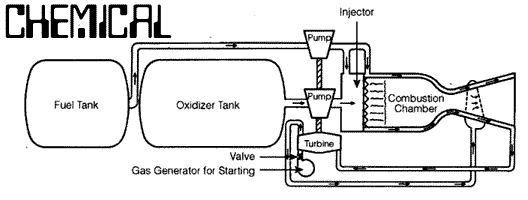 Chemical: Hydrogen-Oxygen. The same thing used on the Space Shuttle.  D-T Fusion: DEUTERIUM-TRITIUM FUSION. Fuel: deuterium and tritium. Propellant: lithium. H-B Fusion: HYDROGEN-BORON FUSION: Fuel is hydrogen and boron. Propellant is hydrogen. A pity about the low thrust. The fusion drives in Larry Niven's "Known Space" novels probably have performance similar to H-B Fusion, but with millions of newtons of thrust. He3-D Fusion: HELIUM 3-DEUTERIUM FUSION. Fuel is helium3 and deuterium. Propellant is hydrogen. IC Fusion: INERTIAL CONFINEMENT FUSION. A pellet of fusion fuel is bombarded on all sides by strong pulses from laser or particle accelerators. The inertia of the fuel holds it together long enough for most of it to undergo fusion.  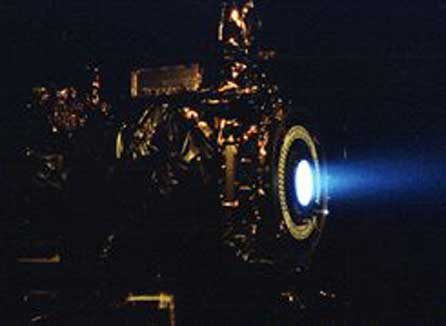 Ion: Potassium seeded argon is ionized and the ions are accelerated electrostatically by electrodes. Other propellants can be used, such as cesium and buckyballs. Though it has admirably high exhaust velocity, there are theoretical limits that ensure all Ion drives are low thrust. It also shares the same problem as the other electrically powered low-thrust drives. In the words of a NASA engineer the problem is "we can't make an extension cord long enough." That is, electrical power plants are weighty enough to make the low thrust an even larger liability. If you are interested in the technical details about why ion drives are low thrust, read the next two paragraphs by Dr. John Schilling. And it suffers from the same critical thrust-limiting problem as any other ion engine: since you are accelerating ions, the acceleration region is chock full of ions. Which means that it has a net space charge which repels any additional ions trying to get in until the ones already under acceleration manage to get out, thus choking the propellant flow through the thruster. The upper limit on thrust is proportional to the cross-sectional area of the acceleration region and the square root of the voltage gradient across the acceleration region, and even the most optimistic plausible values (i.e. voltage gradients just shy of causing vacuum arcs across the grids) do not allow for anything remotely resembling high thrust. Erik Max Francis adds: You can only increase particle energy so much; you then start to get vacuum arcing across the acceleration chamber due to the enormous potential difference involved. So you can't keep pumping up the voltage indefinitely. To get higher thrust, you need to throw more particles into the mix. The more you do this, the more it will reduce the energy delivered to each particle. It is a physical limit. Ion drives cannot have high thrusts. J x B Electric: "Jay cross Bee". A crossed field plasma accelerator.  LANTR: LOX-AUGMENTED NUCLEAR THERMAL ROCKET. This concept involves the use of a "conventional" hydrogen (H2) NTR with oxygen (O2) injected into the nozzle. The injected O2 acts like an "afterburner" and operates in a "reverse scramjet" mode. This makes it possible to augment (and vary) the thrust (from what would otherwise be a relatively small NTR engine) at the expense of reduced Isp MC Fusion: MAGNETIC CONFINEMENT FUSION. A magnetic bottle contains the fusion reaction. Very difficult to do. Researchers in this field say that containing fusion plasma in a magnetic bottle is like trying to support a large slab of gelatin with a web of rubber bands. Making a magnetic bottle which has a magnetic rocket exhaust nozzle is roughly 100 times more difficult. Meta-helium He*: SPIN-POLARIZED TRIPLET HELIUM. Three helium atoms are aligned in a metastable state. When it reverts to normal state it releases 0.48 gigjoules per kilogram. The trouble is that it tends to decay spontaneously, with a lifetime of a mere 2.3 hours. Meta-helium He IV-A: DIATOMIC METASTABLE HELIUM. One normal and one excited helium atom are paired to form a stable solid. The trick is to keep the touchy stuff from exploding prematurely and destroying the spacecraft. The fuel is stored in a resonant waveguide. This is another propulsion system that renders the spacecraft unusually vulnerable to weapons strikes. Mini-MagOrion: This is a sort of micro-fission Orion propulsion system. The fuel and propellant are subcritical pellets of Curium-245. These are compressed electrodynamically by a Z-pinch magnetic field until they reach criticality and explode. The momentum from the explosion is transferred to the spacecraft by the magnetic field. The field coils are attached to a shock absorber Orion style. The detonations occur at a rate of 1 Hz. MPD: MAGNETOPLASMADYNAMIC. A travelling wave plasma accelerator. Propellant is potassium seeded helium. NSWR: NUCLEAR SALT-WATER ROCKET. This concept by Dr. Zubrin is considered far-fetched by many scientists. The fuel is a 20% solution of Uranium tetrabromide in water. The fuel tanks are thin capillary tubes embedded in a neutron damper (like cadmium) to prevent a chain reaction. The fuel is injected into the reaction chamber to create a critical mass. It is basically a continuously detonating Orion type drive with water as propellant. The controversy is over how to contain such a reaction. Zubrin maintains that skillful injection of the fuel can force the reaction to occur outside the reaction chamber. Naturally in such a spacecraft, damage to the fuel tanks can have unfortunate results (say, damage caused by hostile weapons fire). The advantage of NSWR is that this is the only known propulsion system that combines high exhaust velocity with high thrust. The disadvantage is that it combines many of the worst problems of the Orion and Gas Core systems. For starters, using it for take-offs will leave a large crater that will glow blue for several hundred million years, as will everything downwind in the fallout area. 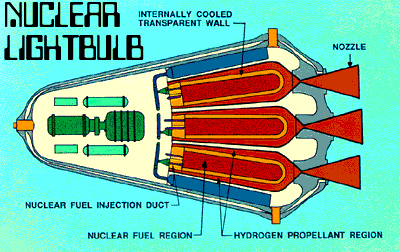 NTR-GAS-Closed: CLOSED-CYCLE GASEOUS CORE FISSION / NUCLEAR THERMAL ROCKET aka "Nuclear Lightbulb". Similar to a gas core fission rocket, but the uranium plasma is confined in a fused quartz chamber. The good news is that there is no uranium escaping in the exhaust. The bad news is that the exhaust velocity is halved. NTR-GAS-Coaxial: GASEOUS CORE COAXIAL FLOW FISSION / NUCLEAR THERMAL ROCKET 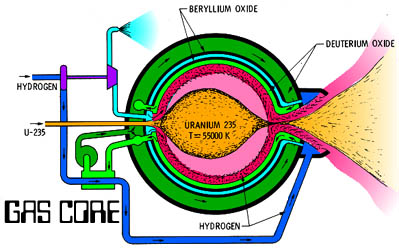 NTR-GAS-Open: GASEOUS CORE FISSION / NUCLEAR THERMAL ROCKET aka consumable nuclear rocket, plasma core, fizzler, cavity reactor rocket. The limit on NTR-SOLID exhaust velocities is the melting point of the reactor. Some engineer who obviously likes thinking "outside of the box" tried to make a liability into a virtue. They asked the question "what if the reactor was already molten?" Gaseous uranium is injected into the reaction chamber until there is enough to start a furious chain reaction. Hydrogen is then injected into the center of this nuclear inferno where is flash heats and shoots out the exhaust nozzle. The trouble is the uranium shoots out the exhaust as well. The reaction is maintained in a vortex tailored to minimize loss of uranium out the nozzle. Fuel is uranium hexaflouride (U235F6) , propellant is hydrogen. The loss of uranium in the exhaust reduces efficiency and angers environmentalists. If used for lift off it can result in a dramatic decrease in the property values around the spaceport. Amusingly enough, this is the best match for the propulsion system used in the TOM CORBETT: SPACE CADET books. However the books are sufficiently vague that it is possible the Polaris used a nuclear lightbulb. According to technical advisor Willy Ley, "reactant" is the hydrogen propellant, but the books imply that reactant is the liquid uranium.  NTR-LIQUID: NUCLEAR THERMAL ROCKET / LIQUID CORE FISSION. Similar to an NTR-GAS, but the fissionable core is merely molten, not gaseous. 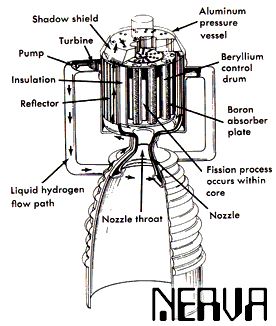  NTR-SOLID: NUCLEAR THERMAL ROCKET / SOLID CORE FISSION. It's a real simple concept. Put a nuclear reactor on top of an exhaust nozzle. Instead of running water through the reactor and into a generator, run hydrogen through it and into the nozzle. By diverting the hydrogen to a turbine generator 60 megawatts can be generated. The reactor elements have to be durable, since erosion will contaminate the exhaust with fissionable materials. The exhaust velocity limit is fixed by the melting point of the reactor. Hydrogen gives the best exhaust velocity, but the other propellants are given in the table since a spacecraft may be forced to re-fuel on whatever working fluids are available locally (Wilderness re-fuelling or "the enlisted men get to go out and shovel whatever they can find into the propellant tanks"). Another reason to avoid hydrogen is the difficulty of storing the blasted stuff, and its annoyingly low density (Ammonia is about eight times as dense!). Exhaust velocities are listed for a realistically attainable core temperature of 3200 degrees K for the propellants Hydrogen (H2), Methane (CH4), Ammonia (NH3), Water (H2O), Carbon Dioxide (CO2), Carbon Monoxide (CO), and Nitrogen (N2) Dr. John Schilling figures that as an order of magnitude guess, about one day of full power operation would result in enough fuel burnup to require reprocessing of the fissionable fuel elements. (meaning that while there is still plenty of fissionables in the fuel rod, enough by-products have accumulated that the clogged rod produces less and less energy) A reprocessing plant could recover 90-95% of the fuel. With reprocessing, in the long term each totally consumed kilogram of plutonium or highly enriched uranium (HEU) will yield ~1E10 newton-seconds of impulse at a specific impulse of ~1000 seconds. Dr. Schilling also warns that there is a minimum amount of fissionable material for a viable reactor. Figure a minimum of 50 kilograms of HEU. NTR-SOLID-DUMBO: This was a competing design to NERVA. It was shelved political decision that, (in order to cut costs on the atomic rocket projects) required both projects to use an already designed NEVRA engine nozzle. Unfortunately, said nozzle was not compatible with the DUMBO active cooling needs.. Dumbo does, however, have a far superior mass flow to the NERVA, and thus a far superior thrust. Dumbo actually had a thrust to weight ratio greater than one. NASA still shelved DUMBO because [a] NERVA used off the shelf components and [b] they knew there was no way in heck that they could get permission for nuclear lift-off rocket so who cares if T/W < 0? NTR-SOLID-NERVA: NUCLEAR ENGINE for ROCKET VEHICLE APPLICATIONS. The first type of NTR-SOLID propulsion systems. It used reactor fuel rods surrounded by a neutron reflector. Unfortunately its thrust to weight ratio is less than one, so no lift-offs with this rocket. The trouble was inadequate propellant mass flow, the result of trying to squeeze too much hydrogen through too few channels in the reactor. NTR-SOLID-PBed: PARTICLE BED / NUCLEAR THERMAL ROCKET aka fluidized-bed, dust-bed, or rotating-bed reactor. In the particle-bed reactor, the nuclear fuel is in the form of a particulate bed through which the working fluid is pumped. This permits operation at a higher temperature than the solid-core reactor by reducing the fuel strength requirements . The core of the reactor is rotated (approximately 3000 rpm) about its longitudinal axis such that the fuel bed is centrifuged against the inner surface of a cylindrical wall through which hydrogen gas is injected. This rotating bed reactor has the advantage that the radioactive particle core can be dumped at the end of an operational cycle and recharged prior to a subsequent burn, thus eliminating the need for decay heat removal, minimizing shielding requirements, and simplifying maintenance and refurbishment operations. 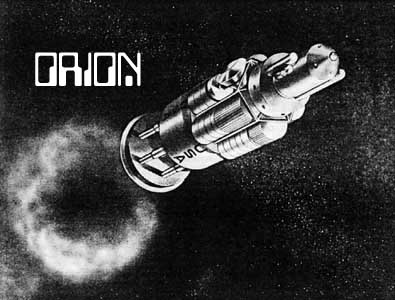 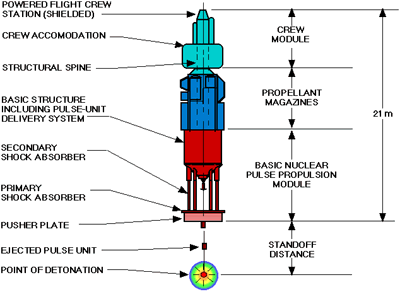  ORION: CONSUMABLE NUCLEAR THERMAL ROCKET aka "old Boom-boom". The ultimate consumable nuclear rocket, based on the "firecracker under a tin can" principle. This concept has the spacecraft mounted with shock absorbers on an armored "pusher plate". A stream of small (5 to 15 kiloton) fission or fusion explosives are detonated under the plate to provide thrust. While you might find it difficult to believe that the spacecraft can survive this, you will admit that this will give lots of thrust to the spacecraft (or its fragments). On the plus side, a pusher plate that can protect the spacecraft from the near detonation of nuclear explosives will also provide dandy protection from any incoming weapons fire. On the minus side I can hear the environmentalists howling already. It will quite thoroughly devastate the lift-off site, and give all the crew bad backs and fallen arches. And they had better have extra-strength brassieres and athletic supporters. However, there is a recent report that suggests ways of minimizing the fallout from an ORION doing a ground lift-off (or a, wait for it, "blast-off" {rimshot}). Apparently if the launch pad is a large piece of armor plate with a coating of graphite there is very little fallout. 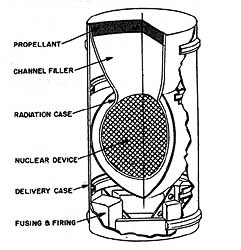 Each pulse unit has a radiation case that channels the initial blast upwards towards the pusher plate. Along the way it vaporizes a solid chunk of propellant and accelerates it to the plate. The device is basically a nuclear shaped charge. Each charge accelerates the spacecraft by roughly 12 m/s. A 4,000 ton spacecraft would use 5 kiloton charges, and a 10,000 ton spacecraft would use 15 kiloton charges. For blast-off, smaller charges of 0.15 kt and 0.35 kt respectively would be used while within the Earth's atmosphere. The air between the charge and the pusher plate amplifies the impulse delivered. The propellant is tungsten, the channel filler is beryllium oxide, and the radiation case is uranium. A 5 kiloton charge is about 850 kg. So the x-rays and other radiation from the nuclear explosion are channeled by the x-ray opaque uranium up into the beryllium oxide channel filler. This absorbs the radiation, converting it into heat. The heat blasts upward, flashing the tungsten propellant into a jet of tungsten plasma. The jet hits the pusher plate, accelerating the spacecraft. The jet is confined to a cone about 22.5 degrees. The following table is from a 1959 report on Orion, and is probably a bit optimistic. But it makes for interesting reading.
Dv 10 km/s = Earth surface
to 480 km Earth orbit NASA has been quietly re-examining ORION, under the new name of "External Pulsed Plasma Propulsion". As George Dyson observed, the new name removes most references to "Nuclear", and all references to "Bombs."  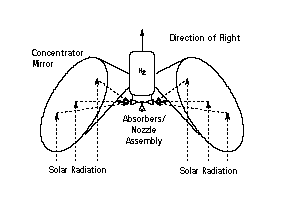

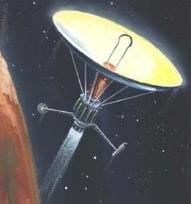
Painting on the right by Professor Sol Dember
Solar Moth: SOLAR THERMAL ROCKET 175 meter diameter aluminum coated reflector concentrates solar radiation onto a window chamber hoop boiler, heating and expanding the propellant through a regeneratively-cooled hoop nozzle. The concentrating mirror is one half of a giant inflatable balloon, the other half is transparent. Propellant is hydrogen seeded with alkali metal. The advantage is that you have power as long as the sun shines. The disadvantage is it doesn't work well past the orbit of Mars and the exhaust velocity is pathetic. This might be carried on a spacecraft as an emergency propulsion system, since the engine mass is so miniscule. 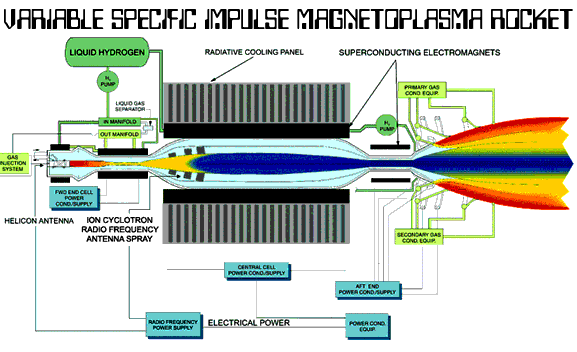 VASIMR: VARIABLE SPECIFIC IMPULSE MAGNETOPLASMA ROCKET. This is a plasma drive with the amusing ability to "shift gears." This means it can trade exhaust velocity for thrust and vice versa. Three "gears" are shown on the table. |
Alıntı: http://www.projectrho.com/rocket/rocket3c2.html
Hiçbir yazı/ resim izinsiz olarak kullanılamaz!! Telif hakları uyarınca bu bir suçtur..! Tüm hakları Çetin BAL' a aittir. Kaynak gösterilmek şartıyla siteden alıntı yapılabilir.
The Time Machine Project © 2005 Cetin BAL - GSM:+90 05366063183 -Turkiye/Denizli
Ana Sayfa /İndex /Roket bilimi / ![]() E-Mail /CetinBAL /Quantum Teleportation-2
E-Mail /CetinBAL /Quantum Teleportation-2
Time Travel Technology /Ziyaretçi Defteri / Duyuru / UFO Technology